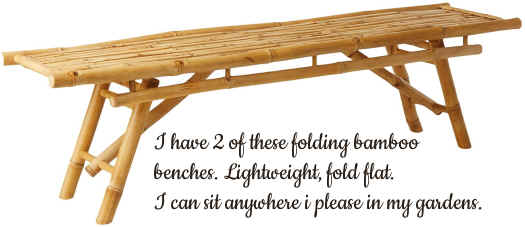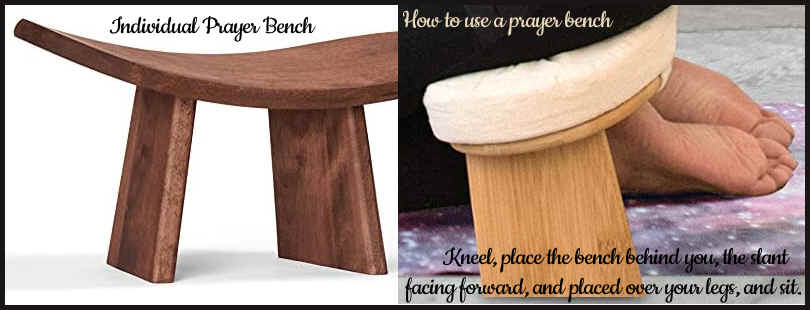For an extensive list of the traditional and important plants for the sacred dedicated Mary Garden, visit this page. For a listing of flowers and plants to grow in a Biblical Garden, visit this page.
 |
|
The Faith or Reverie Garden - Personal space to assist you in prayer - Creating a peaceful Prayer Garden that reflects your faith or beliefs. Meditation, zen, healing and spiritual gardens, saints gardens, reflection and serenity gardens...These all have a lot in common. Places for searching within, for thanksgiving, requesting aid, praying for someone's health, or expressing devotion. A beautiful place to celebrate certain holy days in thoughtful reflections, to mourn and to ask and to give thanks. A prayer or faith garden is specifically meant to be a deeply personal garden, one that is designed for your personal devotion, and symbolizes your inner faith, your method of praying, ritual and timing of prayer. The combination of personal iconic symbols, fragrances, sounds, and beautiful artwork in a natural setting adds another dimension to your prayer rituals. A gardener has a lot of faith and hope, just by virtue of our attempts to beautify and celebrate our space and to grow living things with Mother Nature's blessings and assistance. So many people say they aren't religious, and that they don't pray. They may not pray in a certain way, to a certain deity, in a house of worship, in public or out loud. But my feeling is that any time we ask for spiritual help, ask for forgiveness, asistance, hope for a friend's safety and well-being, mourn a death or open our hearts in thanks..... we are praying. The prayer garden is usually viewed as a Catholic, or at least a Christian, endeavor, but a prayer garden can mean many things in many cultures and faiths. Naming your garden a Faith or Prayer Garden expresses your view of faith and how you pray. My ideal Prayer Garden is a Faith Garden. I'm not religious in an organized denominational way. I am respectful of all beliefs that share the same messages of peace, compassion, love, goodness and charity. My favorite part of my garden, one that I call my St. Francis garden, also contains Mary, lilies and angels. Several representations of St. Francis with the animals reside among the flowers and plants and protect my space. My gardens are bird and butterfly sanctuaries, so the scene is set for easy and natural meditations, and my garden theme's focus is upon Francis and Nature, with Nature participating in the ways she knows best. That space is expanding into a A Saints Garden. Images of Mary as nurturer, protector and as The Madonna, and a few lovely biblical-style (not cutesy) angels are beginning to be part of my dedicated spaces for reflection, peace, and prayer. I have two prayer gardens at this time - The Saints Garden and the Zen (Buddhist) reverie garden. A prayer garden can contain several elements of spiritual beliefs or it can be all-encompassing to be prayerful for any faith. If you treasure all faiths, then a Faith Garden is perfect. Statuary and symbolic flowers and plants can fill your space. If you wish to devote your garden to a particular saint or religious belief, then that's what you should create. I like to call my spiritual spaces as Faith Gardens that celebrate all that's good in all religions, and i like to decorate it with symbols that reflect those beliefs and cultures. I guess that would be a non-denominational prayer garden, an All-Faith garden. I haven't settled on a preferred name. A garden especially for prayer will make you happier in the focus of your attention on the prayer, with no distraction from other people or sounds from other areas of your backyard. The quality of your prayer and the time you spend doing it will increase dramatically. There is even a Rosary Garden for the devout, which is a little more complicated in layout, due to the laying out of certain numbers and shapes of stones, but very do-able. You can easily adapt this simple design plan to more elaborate church and chapel gardens, rectory gardens, Synagogue gardens, and hospital/hospice peace gardens. Designing in quadrants is a great way to fill your sacred spaces with all symbols of your faith, or all faiths. A border of small hedges, as in a parterre garden, or a border of flowers, like lilies or irises around a statue of Mary.... something in the four corners will give each area the focus you choose. A clear focal point would be in the center of each quadrant, and a statue in honor of a saint, an angel figure, a cross, Star of David, The Buddha, or a water feature would be beautiful. The area in the center of the garden itself, in the center of the 4-garden grouping, can be any large or prominent focal point, and taller than the 4 quadrant centerpieces, with edging, but without a hedge border. A seating area in the space with a fig or other cluster of biblical trees in pots can be the focus of your center. For design ideas to use as a guide to a quadrant layout, here's a parterre and celtic knot garden design. The garden can be a small area of your back or front yard garden with a bench, or a table and a chair for resting, or it can be expansive enough to fill your backyard flower gardens with saints and prayerful opportunities, spread out for a spiritual garden experience. There are several stone-look benches, birdbaths and urns made of lighter-weight resin that look quite like stone. But they're easy to move around and sturdy. Many are made with crushed stone bonded with cement. Bamboo goes well in Asian style flower and zen gardens, and wrought iron looks pretty in any style prayer garden area. White seating pieces are beautiful in a prayer garden, but so are the bronzes, bamboo, and cement pieces. The use of stone, cement, or stone-look pieces in a religious garden evokes a sense of antiquity and permanency, and should be a part of your sanctuary plan. Stick with natural materials, and realistic religious representation statues for reverie. Avoid inexpensive or plastic patio decor and accessories, accessories, unrealistic smiling or amusing animal figures, and stick with ethereal beings and religious figures. Don't use everyday garden figures of people, pets, fairies or gnomes as residents in the faith garden. Use only religious or biblical icons and statuary. Birds, bees and butterflies are the best ornaments to use, as are birdhouses and birdbaths, and small water features, and will best represent creatures great and small. Avoid all ornamentation that is silly, comical or not good for meditation. Do not plant a vegetable garden in this area, it would be out of place and require maintenance, but do plant healing and fragrant herbs in pots as borders, or anywhere you can fit one. Grow dwarf biblical fruit trees in stone or big terra cotta (or terra cotta-look) pots. Do not place your BBQ grill, folding and picnic tables in that area, and do not eat your meals in that space. Do place a seat or two and small table in secret or protected areas for prayer and meditation, and space to enjoy a cup of tea or coffee before or after prayer. Add solar lights - small laterns hanging from tree branches, strings of clear, non-blinking solar fairy lights for your evening's visit, and candles for your table. Don't light up the entire garden. Lights should be placed on either all the tall plantings, or all of the understory plantings, but not all over the place. That would be distracting. If you have a walking or prayer path through your garden, make it of grass tile, crushed stone, mulch, stone tiles, or cedar plank walkways. Plain, stone-look, terra cotta, brick or slate stepping stones are nice. Skip decorative or glowing stones and stones with words. Use pathlights for safety, but no color-changing, or bright spotlights on the ground or shining on the statues. A solar flickering candle, lantern or single solar flower stem light near the feet of your saints and near the angels is very pretty. The area should feel peaceful, holy and private, somewhat dimly and sparsely lit. A sanctuary. Most of all, keep garden maintenance simple with terra cotta or other stone-look pots with trees, shrubs, and flowers, and trellises to keep vines neat and growing vertical.
The elements in your garden should all be symbolic and mean something personal to you in terms of how and what you practice in your faith, and should also contain soothing images and structures pertaining to it. Water features, like fountains and small ponds, fit right into the peaceful space you are trying to create. Angels, religious figures, decorative symbols, are important in a faith garden, whatever your beliefs are. The garden can be divided into quadrants, with a particular religious focus in each one, and a focus in the center that ties in the religious messages you wish to convey. The symbolism is a very important part of your sacred space. My favorite examples of symbolic and ornamental garden decor for prayer gardens are below. You will find your favorite symbols in many garden statue outlets, garden supply and religious catalogs, and nurseries. Multi-Faith and non-denominational Prayer Gardens contain several different symbols of faith. Combine patron saints of the garden, Biblical figures, Nature symbols, garden angels, butterfly and bird items, as well as accessories like fountains, offering bowls, planters, chimes, bells, fonts, grottos and birdbaths. Add stone or bamboo seats and accessories to your favorite praying and reflection space. Several of these symbols and accessories are used in my gardens. Choose the imagery that represents your faith and way of praying best. Two beautiful sources of religious statues are Design Toscano and Joseph's Studio - I have several of their beautiful garden sculptures in all of my themes. |

The Celtic Cross |
 |

St. Francis |

The Buddha |
Madonna of The Lilies |

St. Francis |
 |
 |
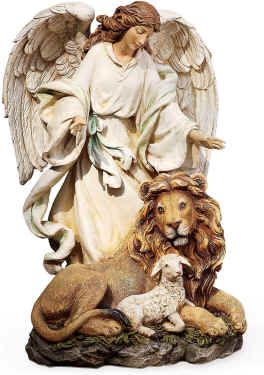 |
 |
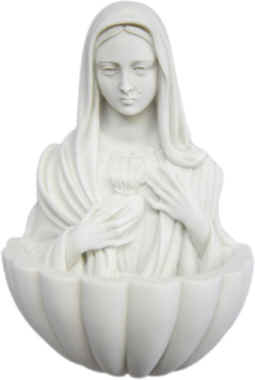 |
 |
| Grow a butterfly and bird habitat to envelop yourself in God's gifts through Nature. You and your garden will be the protectors of God's or and Mother Nature's creatures, and there's nothing more peaceful than birdsong or a graceful and fluttering butterfly joining you while you pray. Add an arbor, arch, trellises, if you wish. Climbing roses and fruits are a beautiful addition to your quiet and reflective retreat, and Madonna Lilies and roses growing in urns and in large white pots are a beautiful tribute to Mary, The Mystic Rose. Building a small grotto and adding her statue creates a special sacred space. A simple arbor or arch in a Biblical or Buddhist Prayer Garden, or any garden, would look stunning with wisteria and other hanging flowers and vines. Big pots of bamboo and Asian Lilies, as well as symbolic biblical dwarf pomegranate trees in pots on the sides of the arch looks beautiful. Birdbaths and feeders are a contribution to your garden's wildlife. And religious angels have a special place in the religious or biblical garden design as well. |
 |
 |
 |
 |
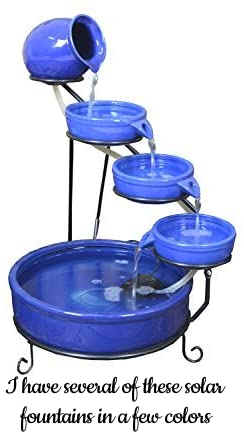 |
 |
 |
 |
 |
|
Your faith or prayer garden is to be the place you will go to for solitude and prayer, during the seasons the weather allows for it. Even when flowers are absent because of weather or because their time is over, make sure you have a seating area, like a bench in a quiet nook or table and chair for 1 - for tea, offerings, and peaceful reflection. Grow 3 seasons of flowering plants and foliage within the gardens so that you can have a rotating selection of beautiful surroundings, and you can use your garden until winter. If you can place your garden where it can be viewed from a window, that will still give you a beautiful place to look at until spring. Growing a few evergreen shrubs and plants that have interesting branches or berries will look beautiful, add a feeder and weatherproof birdbath, and the birds will have food, water and shelter. Fragrance should be used, whether from your flowers, or from incense and candles. An offering can be the centerpiece of your table - cut flowers from the garden on display is a gift of thanks. A bowl of roses can be an offering to Mary. Cut roses placed at her feet are also an offering. Burning crushed sacred herbs in a small bowl, or floating them in a fountain, pond, or ornate little bowl is also an offering. Sanctuary and Devotion candles can be placed on rocks or within your garden. Whatever you can give from your heart that comes from your garden, is appropriate, as well. Just a prayer of thanks is perfectly acceptable as your offering. Sounds - Birds chirping will become natural in a garden that contains feeders, fountains and birdbaths. Chimes and bells add more to that feeling of a protective and joyful sanctuary. Some additional items for your space and rituals are suggested below: |
 |
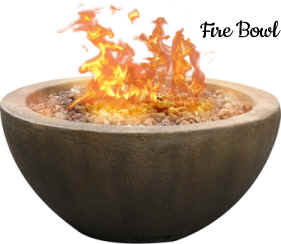
Toss in a few fragrant herbs,
like |
 |

For crushing
herb offerings |
 |
 |
 |
 |
 |
 |
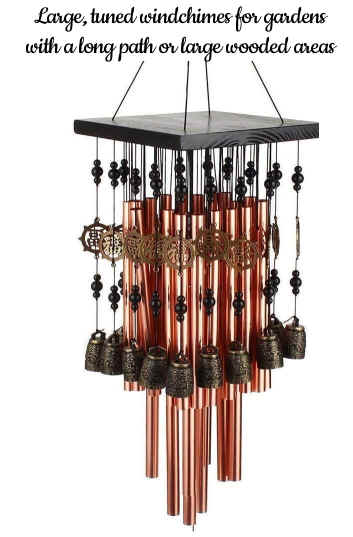 |

You can burn herbs or
offer |
|
Types of religious faith and prayer gardens can include a Rosary Garden, Mary Garden, Patron Saints Garden, Bible Garden, Old Testament Garden, Celtic Spiritual Knot Garden - it's almost limitless, as well as the decor possibilities. Your choice of plants, trees and flowers is important. Combining these in a Faith Garden is a work of love and personal faith. The fig tree and pomegranate are symbolic, so are certain shade and ornamentals. Flowers are favorites of saints and religious figures, and there are a lot of lists of plants for every faith. A combination garden is easy to create. You don't need to organize special items in special sections of the garden, unless you want a dedicated garden (Mary Gardens). A Faith Garden can suit those who respect the best of every faith and the religious figures and symbols associated with them. Many symbolic plants are great as crossovers in a Faith Garden - as well as the specific devoted gardens like the Mary Garden, Judaic, Saints, Buddhist, and Biblical Gardens. To make your days in the garden even more joyful, and plant your flowers, trees and vines in big p0ts and raised beds. That eliminates over-crowding, bugs and weeds. And your garden becomes mobile - you can switch out or move the pots any time you like, to freshen up the look, change it, and grow things not normally growing in your area. Like tropical region plants and blooms. You can bring them indoors over the winter, and put them back out in the spring. It's an easier way to a beautiful garden. Big terra cotta or resin pots, and pots in colors that will show off the colors of the plants are very pretty. Plants climbing a fence or trellis are an easy way to section off private areas. Decorate and plant your garden with items that bring you joy, and sit among them, absorbing the peaceful and thankful feelings they bring. Your prayer garden is also a place to thank not only the symbolic figures of your faith, but appreciate the bounty that was given to you by all forces of nature. And that will help you with your morning or evening prayer rituals. Plants For A Rosary Prayer Garden In a Rosary Garden, where you would
recite the Catholic Rosary as your prayers, the following are some
flower suggestions.
The number of plants that can be used
symbolically in a Rosary garden is extensive. Listed here are just a
few color and plant suggestions representing the mysteries.
For flowers especially for dedicated Mary Gardens, visit this page. A Rosary Garden using these symbolic flowers, that also contains a Mary Garden with Mary's flowers, would be beautiful. Choose perennial plants suitable for the zone you live in by checking the flowers, plants and trees you love on the USDA Zone Hardiness Map for your region. The plants below are suggestions, and you can find hundreds of plants with religions meanings that fit the garden you desire. Whatever your faith might be, there are many plants to grow with religious meaning to choose from. Annuals are not recommended, as they'd have to be replanted every spring, and you want this garden to be as close to zero maintenance as possible, and avoid any distractions when you visit your garden for prayer. Joyful Bluebells Hyssop Sorrowful Cyclamen Morning glory Sea holly or Globe thistle look similar, and are covred with spiny textures. Asters symbolize patience. Mums - Legend has it that mums were growing when Jesus was laid in the tomb. Glorious Easter lily represents everlasting life. Sweet almond tree Columbine has petals shaped like a dove Assumption lily - The fragrant lily blooms in most areas around mid-August, close to the Assumption of Mary Cornflower is known as Mary’s crown. Luminous Bougainvillea (Trinity flower) Woodland phlox - Lady’s Wedding Flower, the uniting of souls. Ivy - “where God has walked.” Thyme- an herb symbolizing strength and courage. Basil - Holy Communion plant. |
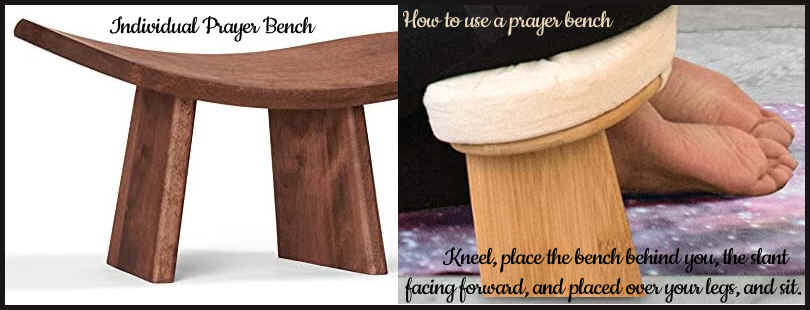 |



